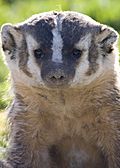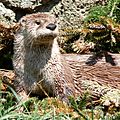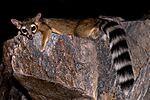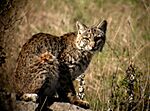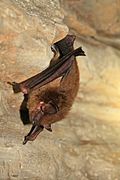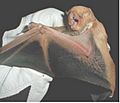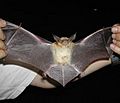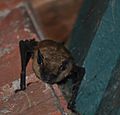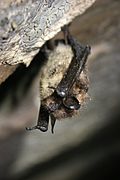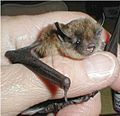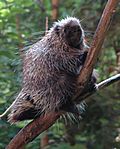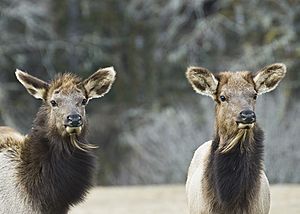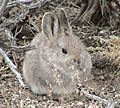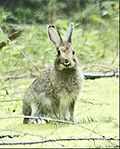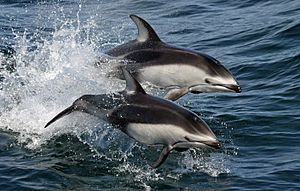List of mammals of Oregon facts for kids
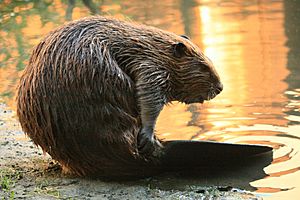
This is a list of all the wild mammals that live in the U.S. state of Oregon, or those that used to live there but are now gone. This list includes animals found on land and along Oregon's coast. We've gathered this information from trusted sources like the American Society of Mammalogists. Sometimes, these lists might have small differences, which we'll point out. The animals are grouped by their main types, called "orders," and then listed in tables by their "families." We also mention how rare or common each species is, based on the IUCN Red List. The pictures you see are of animals from Oregon or nearby states. We don't list animals that are only found in zoos or as pets.
Oregon is home to many different kinds of mammals! There are about 139 different wild mammal species living here or that once lived here. These amazing creatures are grouped into different "orders" based on their shared features. For example, there are many carnivores (meat-eaters), bats, and rodents (like mice and squirrels). Each group plays an important role in Oregon's natural world.
Contents
Protecting Mammals
Animals around the world are given a special status by the IUCN Red List. This helps us understand if they are safe or if they need our help to survive. Animals are put into different groups based on how many there are, if their numbers are shrinking, and where they live.
- Least Concern: These animals are doing well and are not currently in danger.
- Near Threatened: These animals might become threatened in the future, so we need to keep an eye on them.
- Vulnerable: These animals are facing a high risk of becoming endangered.
- Endangered: These animals are in very high danger of disappearing forever.
- Critically Endangered: These animals are extremely close to becoming extinct.
- Extinct in the Wild: These animals only live in zoos or special protected areas, not in nature.
- Extinct: These animals have completely disappeared from Earth.
- Data Deficient: We don't have enough information to know if these animals are safe or in danger.
- Not Evaluated: These animals haven't been checked yet.
Land Mammals
Carnivores
Carnivores are a very diverse group of mammals. Their name comes from a Latin word meaning "flesh devourer," because many of them eat meat. Oregon is home to many different carnivores. The gray wolf has recently returned to Oregon, especially in the northeast. The grizzly bear used to live in Oregon but disappeared around 1940. Even though they are gone, they are still included in this list because they were once part of Oregon's wildlife.
| Common name | Scientific name (who named it, year) |
Family | Where they live and interesting facts | Red List Status |
|---|---|---|---|---|
Coyote |
Canis latrans (Say, 1823) |
Canidae | Coyotes are like a medium-sized dog, between a fox and a wolf. They live all over Oregon. Sometimes, rare white coyotes have been seen! | |
Gray wolf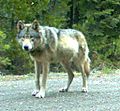 |
Canis lupus (Linnaeus, 1758) |
Canidae | Gray wolves have moved back into Oregon from Idaho. By the end of 2013, there were at least 64 wolves. They are protected by state and federal laws. The first wolf confirmed in Oregon since 1947 was named OR-7, also known as Journey. | |
| Gray fox |
Urocyon cinereoargenteus (Schreber, 1775) |
Canidae | You can find gray foxes all over Oregon. They have grizzled gray fur and a black stripe on their tail. They are active at dawn, dusk, and night. They are special because they can climb trees to rest, find food, or escape danger! | |
| Kit fox |
Vulpes macrotis (Merriam, 1888) |
Canidae | Kit foxes live in the southeast part of Oregon. They are the smallest dog-like animal in North America. They have brownish-gray fur that gets lighter on their belly, and big ears. Their tail tip is black. | |
| Red fox |
Vulpes vulpes (Linnaeus, 1758) |
Canidae | Red foxes are found all over Oregon. Most of them are red, but some can be silver or have a "crossed" pattern. Their numbers grew as wolf populations went down. A special type of red fox, the Sierra Nevada red fox, has been seen near Mount Hood and Crater Lake. | |
| Black bear |
Ursus americanus (Pallas, 1780) |
Ursidae | Black bears are common throughout Oregon's forests. They are usually black, but can sometimes be brown or cinnamon colored. | |
| Grizzly bear |
Ursus arctos (Linnaeus, 1758) |
Ursidae | Grizzly bears used to live all over Oregon, except for the dry eastern parts. The last grizzly in Oregon was killed in 1931. They are now gone from the state. | |
| Wolverine |
Gulo gulo | Mustelidae | Wolverines are very rare in Oregon and are mostly gone from the state. Sometimes, one might wander in from a neighboring state. | |
| Pacific marten |
Martes caurina (Merriam, 1890) |
Mustelidae | These agile animals live in forests, often in older trees. They are good climbers and hunters. | |
American ermine |
Mustela richardsonii | Mustelidae | Ermines are small, quick hunters. Their fur turns white in winter, helping them blend into the snow. | |
| Long-tailed weasel |
Neogale frenata | Mustelidae | These long, slender animals are fierce predators, hunting small rodents and birds. | |
| American mink |
Neogale vison | Mustelidae | Minks are semi-aquatic, meaning they live near water. They are excellent swimmers and hunt fish, frogs, and small mammals. | |
| Fisher |
Pekania pennanti (Erxleben, 1777) |
Mustelidae | Fishers have been brought back to Oregon. They are protected here. They are known for being able to hunt porcupines. | |
| American badger |
Taxidea taxus | Mustelidae | Badgers are more common in the dry, sagebrush deserts of eastern Oregon. They are powerful diggers. | |
| Sea otter |
Enhydra lutris | Mustelidae | Sea otters used to live along Oregon's coast but were hunted until they disappeared in the early 1900s. Attempts to bring them back in the 1970s didn't work. Any sightings now are likely otters that have wandered from other states. | |
| North American river otter |
Lontra canadensis | Mustelidae | River otters are playful animals found in rivers and lakes across Oregon. They are excellent swimmers and divers. | |
| Striped skunk |
Mephitis mephitis | Mephitidae | Striped skunks are well-known for their strong-smelling spray, which they use to defend themselves. They are common in many habitats. | |
| Western spotted skunk |
Spilogale gracilis | Mephitidae | These skunks are smaller than striped skunks and have a more intricate pattern of white spots and stripes. They can also do a handstand before spraying! | |
| Northern fur seal |
Callorhinus ursinus | Otariidae | Northern fur seals spend most of their lives in the ocean, coming to land only to breed. | |
| Steller sea lion |
Eumetopias jubatus | Otariidae | Steller sea lions are the largest sea lions in the world. You can often see them resting on rocks along the Oregon coast. | |
| Harbor seal |
Phoca vitulina | Phocidae | Harbor seals are common along Oregon's coast, often seen resting on beaches or floating in the water. | |
| Northern elephant seal |
Mirounga angustirostris | Phocidae | Northern elephant seals are huge marine mammals. Males have a large, trunk-like nose. They come to shore to breed and molt. | |
| Ring-tailed cat | Bassariscus astutus | Procyonidae | Despite their name, ring-tailed cats are more closely related to raccoons. They are nocturnal and excellent climbers. | |
| Raccoon |
Procyon lotor | Procyonidae | Raccoons are very adaptable animals found in many parts of Oregon, including urban areas. They are known for their masked faces and clever paws. | |
| Canada lynx |
Lynx canadensis | Felidae | Canada lynx used to live in many parts of Oregon, including the Cascade Mountains. They are now gone from the state. They were protected under federal law in 2000. | |
| Bobcat | Lynx rufus | Felidae | Bobcats are wild cats found throughout Oregon. They are smaller than mountain lions and have short, "bobbed" tails. | |
| Mountain lion |
Puma concolor | Felidae | Mountain lions, also called cougars, are large wild cats found in many parts of Oregon. They are powerful hunters. |
Bats
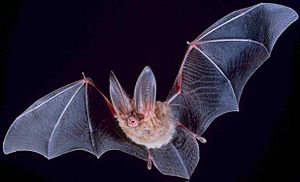
Bats are the only mammals that can truly fly! Oregon is home to many different kinds of bats. They are very important for controlling insects and pollinating plants. Many bats use echolocation, sending out sounds and listening for echoes, to navigate and find food in the dark.
| Common name | Scientific name (who named it, year) |
Family | Where they live and interesting facts | Red List Status |
|---|---|---|---|---|
| Big brown bat |
Eptesicus fuscus | Vespertilionidae | These bats are common and can be found in many different habitats, including near human homes. | |
Western pipistrelle or canyon bat |
Pipistrellius hesperus | Vespertilionidae | This is the smallest bat found in Oregon. It often flies early in the evening. | |
| Western red bat |
Lasiurus blossevillii | Vespertilionidae | These bats have reddish fur and often roost in trees, blending in with leaves. | |
| Hoary bat |
Lasiurus cinereus | Vespertilionidae | Hoary bats are one of the largest bats in Oregon. They have frosted fur, giving them a "hoary" appearance. | |
| Townsend's big-eared bat |
Corynorhinus townsendii | Vespertilionidae | These bats are easy to spot because of their incredibly long ears! They often roost in caves and old mines. | |
| Spotted bat |
Euderma maculatum | Vespertilionidae | Spotted bats are striking with their black fur and large white spots. They have huge ears and a unique call. | |
| Pallid bat |
Antrozous pallidus | Vespertilionidae | Pallid bats are usually found in desert areas. They are known for eating large insects like scorpions and centipedes. | |
| Silver-haired bat |
Lasionycteris noctivagans | Vespertilionidae | These bats have dark fur tipped with silver, giving them a frosted look. They often roost in tree cavities. | |
| Californian myotis |
Myotis californicus | Vespertilionidae | This is one of the smallest bats in the Myotis group, found in various habitats. | |
| Western small-footed bat |
Myotis ciliolabrum | Vespertilionidae | These bats have tiny feet, as their name suggests. They are often found in dry, rocky areas. | |
| Little brown myotis |
Myotis lucifugus | Vespertilionidae | Once very common, these bats are now facing threats from a disease called White-nose Syndrome. | |
| Dark-nosed small-footed myotis |
Myotis melanorhinus | Vespertilionidae | This bat is similar to the Western small-footed bat but has a darker nose. | |
| Fringed myotis |
Myotis thysanodes | Vespertilionidae | Fringed myotis bats have stiff hairs along the edge of their tail membrane, which helps them scoop up insects. | |
| Long-legged myotis |
Myotis volans | Vespertilionidae | These bats have long legs and large feet, which are useful for catching insects in flight. | |
| Yuma myotis |
Myotis yumanensis | Vespertilionidae | Yuma myotis bats often live near water sources, where they hunt insects. | |
| Brazilian/Mexican free-tailed bat |
Tadarida brasiliensis | Molossidae | These bats are known for their long, narrow wings and fast flight. They often form huge colonies. |
Rodents

Rodents are the largest group of mammals, and Oregon has many different kinds! They include animals like mice, rats, squirrels, and beavers. The North Oregon Coast population of red tree voles is being considered for protection under the Endangered Species Act because their numbers are declining.
| Common name | Scientific name (who named it, year) |
Family | Where they live and interesting facts | Red List Status |
|---|---|---|---|---|
| Mountain beaver |
Aplodontia rufa | Aplodontidae | Despite their name, mountain beavers are not true beavers. They are ancient rodents that dig complex tunnel systems. | |
| North American beaver |
Castor canadensis | Castoridae | Beavers are famous for building dams and lodges. They are the largest rodents in North America and are Oregon's state mammal. | |
| Common porcupine |
Erethizon dorsatum | Erethizontidae | Porcupines are known for their sharp quills, which they use for defense. They are mostly active at night. | |
| Nutria |
Myocastor coypus | Myocastoridae | Nutria are large, semi-aquatic rodents that were brought to Oregon from South America. They can cause damage to wetlands. | |
| Long-tailed vole |
Microtus longicaudus | Cricetidae | These voles have longer tails than most other voles. They live in various habitats, from forests to grasslands. | |
| Montane vole |
Microtus montanus | Cricetidae | Montane voles are common in meadows and grasslands, especially in mountainous areas. | |
| Creeping vole |
Microtus oregoni | Cricetidae | Creeping voles are small and often found in damp, grassy areas. | |
| North American water vole |
Microtus richardsoni | Cricetidae | Water voles are good swimmers and live near streams and wet meadows. | |
| Townsend's vole |
Microtus townsendii | Cricetidae | Townsend's voles are common in wet, grassy areas of western Oregon. | |
| Bushy-tailed woodrat |
Neotoma cinerea | Cricetidae | These woodrats build large nests, often in rocky areas or old buildings. They have bushy tails like squirrels. | |
| Dusky-footed woodrat |
Neotoma fuscipes | Cricetidae | Dusky-footed woodrats build impressive "middens" or nests out of sticks and debris. | |
| Desert woodrat |
Neotoma lepida | Cricetidae | Desert woodrats live in dry, desert environments and are adapted to hot conditions. | |
| Common muskrat |
Ondatra zibethicus | Cricetidae | Muskrats are semi-aquatic rodents that build lodges in wetlands and slow-moving water. | |
Northern grasshopper mouse |
Onychomys leucogaster | Cricetidae | Unlike most mice, grasshopper mice primarily eat insects and other small animals. They even howl like tiny wolves! | |
| White-footed vole |
Arborimus albipes | Cricetidae | These voles have white feet and live in forests, often climbing trees. | |
Red tree vole |
Arborimus longicaudus | Cricetidae | Red tree voles spend most of their lives in trees, eating conifer needles. | |
Western red-backed vole |
Clethrionomys californicus | Cricetidae | These voles have a reddish stripe down their back and live in forests. | |
Southern red-backed vole |
Myodes gapperi | Cricetidae | Similar to the Western red-backed vole, this species also has a reddish back. | |
| Sagebrush vole |
Lemmiscus curtatus | Cricetidae | Sagebrush voles live in dry, sagebrush habitats of eastern Oregon. | |
California vole |
Microtus californicus | Cricetidae | California voles are common in grasslands and wet meadows. | |
| Gray-tailed vole |
Microtus canicaudus | Cricetidae | These voles have gray tails and are found in western Oregon. | |
| Brush deermouse |
Peromyscus boylii | Cricetidae | Brush deermice are good climbers and live in rocky or brushy areas. | |
| Canyon deermouse |
Peromyscus crinitus | Cricetidae | Canyon deermice are found in dry, rocky canyons and deserts. | |
Western deermouse |
Peromyscus sonoriensis | Cricetidae | Western deermice are very common and found in almost every habitat type. | |
Piñon deermouse |
Peromyscus truei | Cricetidae | Piñon deermice live in areas with pine and juniper trees. | |
| Western heather vole |
Phenacomys intermedius | Cricetidae | These voles are found in high-elevation forests and meadows. | |
Western harvest mouse |
Reithrodontomys megalotis | Cricetidae | Western harvest mice are small and live in grassy areas, often building nests in tall vegetation. | |
Botta's pocket gopher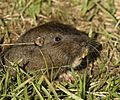 |
Thomomys bottae | Geomyidae | Pocket gophers are known for their large cheek pouches, which they use to carry food. They dig extensive tunnels. | |
Northern pocket gopher |
Thomomys talpoides | Geomyidae | Northern pocket gophers are common in many parts of Oregon, creating mounds of dirt as they dig. | |
Mazama pocket gopher |
Thomomys mazama | Geomyidae | This gopher is found in specific areas, often in mountain meadows. | |
| Townsend's pocket gopher |
Thomomys townsendii | Geomyidae | Townsend's pocket gophers are larger than other gophers and live in moist soils. | |
Camas pocket gopher |
Thomomys bulbivorus | Geomyidae | This gopher is found in the Willamette Valley and is named after the camas plant, whose bulbs it eats. | |
| California kangaroo rat |
Dipodomys californicus | Heteromyidae | Kangaroo rats have very long hind legs and tails, allowing them to hop like kangaroos. They live in dry areas. | |
Yellow-pine chipmunk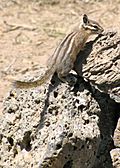 |
Tamias amoenus | Sciuridae | These chipmunks are common in pine forests and are known for their striped faces and quick movements. | |
Least chipmunk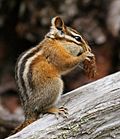 |
Tamias minimus | Sciuridae | The least chipmunk is the smallest chipmunk species and can be found in various habitats. | |
North American red squirrel |
Tamiasciurus hudsonicus | Sciuridae | Red squirrels are noisy and active, often chattering as they defend their territory. They eat conifer seeds. | |
Belding's ground squirrel |
Urocitellus beldingi | Sciuridae | These ground squirrels live in colonies in open, grassy areas and are known for their "picket-pin" posture when standing alert. | |
| Merriam's ground squirrel |
Urocitellus canus | Sciuridae | Merriam's ground squirrels live in dry, open habitats in eastern Oregon. | |
Columbian ground squirrel |
Urocitellus columbianus | Sciuridae | These large ground squirrels are found in mountain meadows and open forests. | |
Wyoming ground squirrel |
Urocitellus elegans | Sciuridae | Wyoming ground squirrels live in sagebrush and grasslands in eastern Oregon. | |
Chisel-toothed kangaroo rat |
Dipodomys microps | Heteromyidae | This kangaroo rat has special teeth for eating tough plant material. | |
Ord's kangaroo rat |
Dipodomys ordii | Heteromyidae | Ord's kangaroo rats are common in sandy, desert habitats. | |
| Dark kangaroo mouse |
Microdipodops megacephalus | Heteromyidae | Kangaroo mice are tiny, hopping rodents that live in sandy deserts. | |
Little pocket mouse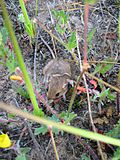 |
Perognathus longimembris | Heteromyidae | These are very small mice with external cheek pouches for carrying seeds. | |
| Great Basin pocket mouse |
Perognathus parvus | Heteromyidae | Great Basin pocket mice live in dry, shrubby areas. | |
House mouse |
Mus musculus | Muridae | House mice are not native to Oregon; they were introduced by humans. | |
Brown rat |
Rattus norvegicus | Muridae | Brown rats are also not native to Oregon and are often found in urban areas. | |
Black rat |
Rattus rattus | Muridae | Black rats are another non-native species, often found near human settlements. | |
Golden-mantled ground squirrel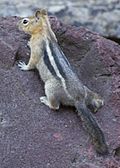 |
Callospermophilus lateralis | Sciuridae | These squirrels look like chipmunks but are larger and lack stripes on their faces. They live in mountain forests. | |
Douglas squirrel |
Tamiasciurus douglasii | Sciuridae | Douglas squirrels are common in western Oregon's conifer forests. They are very vocal. | |
Northern flying squirrel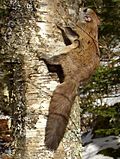 |
Glaucomys sabrinus | Sciuridae | Flying squirrels don't actually fly, but glide using a special membrane between their legs. They are nocturnal. | |
| Humboldt's flying squirrel |
Glaucomys oregonensis | Sciuridae | This is a newly recognized species of flying squirrel found in coastal forests. | |
Yellow-bellied marmot |
Marmota flaviventris | Sciuridae | Yellow-bellied marmots are large ground squirrels that live in rocky, open areas, often in mountains. They whistle loudly to warn others of danger. |
Hoofed Mammals (Artiodactyla)
This group includes mammals with hooves, like deer, elk, and bison. They are mostly plant-eaters.
| Common name | Scientific name (who named it, year) |
Family | Where they live and interesting facts | Red List Status |
|---|---|---|---|---|
Pronghorn |
Antilocapra americana | Antilocapridae | Pronghorns live in the sagebrush deserts of eastern Oregon. They are the fastest mammals in North America, reaching speeds of 50 miles per hour (80 km/h)! | |
American bison |
Bison bison | Bovidae | Bison used to live in eastern and central Oregon but disappeared in the early to mid-1800s. | |
Bighorn sheep |
Ovis canadensis | Bovidae | Bighorn sheep used to be common in eastern Oregon but disappeared. They have been brought back to areas like the Mutton Mountains and Cottonwood Canyon State Park. | |
Mountain goat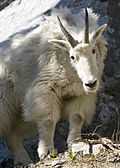 |
Oreamnos americanus | Bovidae | Mountain goats lived in Oregon's northern Cascades and Wallowa Mountains but disappeared. They have been reintroduced to the Wallowa and Elkhorn mountains, and recently to Mount Jefferson. | |
| Elk |
Cervus canadensis | Cervidae | Elk are common throughout Oregon. There are two main types: Roosevelt elk in western Oregon and Rocky Mountain elk in eastern Oregon. | |
Mule deer |
Odocoileus hemionus | Cervidae | Mule deer are common throughout Oregon. They are named for their large, mule-like ears. | |
White-tailed deer |
Odocoileus virginianus | Cervidae | White-tailed deer are also common in Oregon. They are known for their white tail, which they raise when alarmed. | |
Moose |
Alces americanus | Cervidae | A small group of Shiras moose lives in the northeastern part of Oregon, especially in Wallowa County. Moose are the largest animals in the deer family and are plant-eaters. |
Shrews and Moles (Eulipotyphla)
This group includes small, often hidden mammals like shrews and moles. Shrews are tiny, mouse-like animals with long snouts, and moles are expert diggers that live underground.
| Common name | Scientific name (who named it, year) |
Family | Where they live and interesting facts | Red List Status |
|---|---|---|---|---|
| Baird's shrew |
Sorex bairdii | Soricidae | This shrew is only found in northwestern Oregon, living among conifer trees. | |
| Marsh shrew |
Sorex bendirii | Soricidae | Marsh shrews are semi-aquatic and can dive and swim to find food in water. | |
| Masked shrew |
Sorex cinereus | Soricidae | There's some debate about whether this shrew is truly in Oregon, but it's on some lists. | |
| Merriam's shrew | Sorex merriami | Soricidae | Merriam's shrews live in dry, open habitats. | |
| Dusky shrew | Sorex monticolus | Soricidae | Dusky shrews are common in many different habitats, from forests to grasslands. | |
| Pacific shrew | Sorex pacificus | Soricidae | Pacific shrews are found in the coastal forests of Oregon. | |
| American water shrew |
Sorex palustris | Soricidae | These shrews are excellent swimmers and can even run on the surface of water! | |
| Preble's shrew | Sorex preblei | Soricidae | Preble's shrews are small and live in dry, open areas. | |
| Fog shrew | Sorex sonomae | Soricidae | Fog shrews are found in the foggy coastal forests. | |
| Trowbridge's shrew | Sorex trowbridgii | Soricidae | Trowbridge's shrews are common in forests and woodlands. | |
| Vagrant shrew | Sorex vagrans | Soricidae | Vagrant shrews are widespread and can be found in many different habitats. | |
| Shrew mole |
Neurotrichus gibbsii | Talpidae | Shrew moles are the smallest moles and can be found in moist, forested areas. | |
| Broad-footed mole |
Scapanus latimanus | Talpidae | Broad-footed moles are powerful diggers, creating tunnels in various soil types. | |
| Coast mole | Scapanus orarius | Talpidae | Coast moles live in the moist soils of western Oregon, including lawns and gardens. | |
| Townsend's mole |
Scapanus townsendii | Talpidae | Townsend's moles are the largest moles in North America. They create large molehills. |
Hares, Rabbits, and Pikas (Lagomorpha)
This group includes animals like hares, rabbits, and pikas. The name "Lagomorpha" comes from Greek words meaning "hare-shaped." Oregon is home to eight different species in this group.
| Common name | Scientific name (who named it, year) |
Family | Where they live and interesting facts | Red List Status |
|---|---|---|---|---|
| American pika |
Ochotona princeps (Richardson, 1828) |
Ochotonidae | Pikas are small, furry animals that live in rocky areas, especially in mountains. They collect plants to store for winter, making little "haypiles." | |
| Pygmy rabbit |
Brachylagus idahoensis (Merriam, 1891) |
Leporidae | Pygmy rabbits are the smallest rabbits in North America. They live in dense sagebrush in southern Oregon and dig their own burrows. They are mostly active at dawn and dusk. | |
| Snowshoe hare |
Lepus americanus | Leporidae | Snowshoe hares live in northern, south-central, and eastern Oregon. They are known for their large feet, which act like snowshoes, and their fur changes color with the seasons (brown in summer, white in winter). | |
| Black-tailed jackrabbit |
Lepus californicus | Leporidae | Black-tailed jackrabbits live in southwestern Oregon, in open fields, grasslands, and deserts. They are active at night or around dawn and dusk. They rest in shallow dips in the ground during the day. | |
| White-tailed jackrabbit |
Lepus townsendii | Leporidae | White-tailed jackrabbits are found in eastern and central Oregon. They live in fields and grasslands. When chased, they run in a zigzag pattern with quick bursts of speed. | |
| Eastern cottontail |
Sylvilagus floridanus | Leporidae | Eastern cottontails live on the eastern slopes of the Willamette Valley and the Cascades. They are the most common rabbit in this group in Oregon. They are active from dusk to dawn. | |
| Mountain cottontail |
Sylvilagus nuttallii | Leporidae | Mountain cottontails live east of the Cascades, near rivers, streams, and rocky areas. They are active at dawn and dusk and can sometimes climb trees. | |
| Brush rabbit |
Sylvilagus bachmani | Leporidae | Brush rabbits are found in dense brushy areas, as their name suggests. |
Opossums (Didelphimorphia)
There is only one species of opossum found in Oregon.
| Common name | Scientific name (who named it, year) |
Family | Where they live and interesting facts | Red List Status |
|---|---|---|---|---|
| Virginia opossum |
Didelphis virginiana (Kerr, 1792) |
Didelphidae | Virginia opossums were brought to Oregon in the early 1900s. They are known for "playing dead" when scared. |
Marine Mammals
Whales, Dolphins, and Porpoises (Cetacea)
Oregon's coast is home to many amazing marine mammals, including different types of whales, dolphins, and porpoises. These animals are perfectly adapted to life in the ocean.
| Common name | Scientific name (who named it, year) |
Family | Where they live and interesting facts | Red List Status |
|---|---|---|---|---|
| Common minke whale |
Balaenoptera acutorostrata | Balaenopteridae | Minke whales are smaller baleen whales found in coastal waters. | |
Sei whale |
Balaenoptera borealis | Balaenopteridae | Sei whales are fast swimmers and feed on small fish and krill. | |
Blue whale |
Balaenoptera musculus | Balaenopteridae | Blue whales are the largest animals on Earth! They are baleen whales, meaning they filter feed tiny organisms. | |
Fin whale |
Balaenoptera physalus | Balaenopteridae | Fin whales are the second-largest whales and are known as the "greyhounds of the sea" due to their speed. | |
Humpback whale |
Megaptera novaeangliae | Balaenopteridae | Humpback whales are famous for their acrobatic breaches and complex songs. | |
Gray whale |
Eschrichtius robustus | Eschrichtiidae | Gray whales migrate along the Oregon coast. They are known for feeding on the ocean floor. | |
Short-beaked common dolphin |
Delphinus delphis | Delphinidae | These dolphins are very social and often travel in large groups. | |
| Short-finned pilot whale |
Globicephala macrorhynchus | Delphinidae | Pilot whales are large dolphins that live in deep ocean waters. | |
Risso's dolphin |
Grampus griseus | Delphinidae | Risso's dolphins have unique scars on their bodies from interactions with other dolphins and prey. | |
Pacific white-sided dolphin |
Lagernorhynchus obliquidens | Delphinidae | These playful dolphins are often seen riding bow waves of boats along the Oregon coast. | |
Northern right whale dolphin |
Lissodelphis borealis | Delphinidae | Northern right whale dolphins are unique because they have no dorsal fin. | |
Killer whale |
Orcinus orca | Delphinidae | Killer whales, also known as orcas, are powerful predators and the largest dolphins. | |
False killer whale |
Pseudorca crassidens | Delphinidae | False killer whales are large, dark dolphins that look similar to killer whales but are smaller. | |
Striped dolphin |
Stenella coeruleoalba | Delphinidae | Striped dolphins are known for the distinctive stripes on their sides. | |
Harbor porpoise |
Phocoena phocoena | Phocoenidae | Harbor porpoises are small, shy porpoises often found in coastal waters and estuaries. | |
Dall's porpoise |
Phocoenoides dalli | Phocoenidae | Dall's porpoises are fast swimmers with distinctive black and white markings. | |
Sperm whale |
Physeter macrocephalus | Physeteridae | Sperm whales are the largest toothed whales and are known for their huge heads and deep dives. | |
| Pygmy sperm whale |
Kogia breviceps | Kogiidae | Pygmy sperm whales are small, rarely seen whales that live in deep offshore waters. | |
Dwarf sperm whale |
Kogia sima | Kogiidae | Even smaller than pygmy sperm whales, dwarf sperm whales are also found in deep waters. | |
| Baird's beaked whale |
Berardius bairdii | Ziphiidae | Baird's beaked whales are large, deep-diving whales that are rarely seen near shore. | |
| Hubbs' beaked whale |
Mesoplodon carlhubbsi | Ziphiidae | Hubbs' beaked whales are mysterious deep-sea whales with unique markings. | |
Stejneger's beaked whale |
Mesoplodon stejnegeri | Ziphiidae | Stejneger's beaked whales are another type of deep-diving whale, rarely observed. | |
Cuvier's beaked whale |
Ziphius cavirostris | Ziphiidae | Cuvier's beaked whales are the most widespread of the beaked whales, but still live in deep waters. |
See also
- Fauna of Oregon
- List of prehistoric mammals
- Lists of mammals by region
- Mammal classification
- List of mammals described in the 2000s
Images for kids













